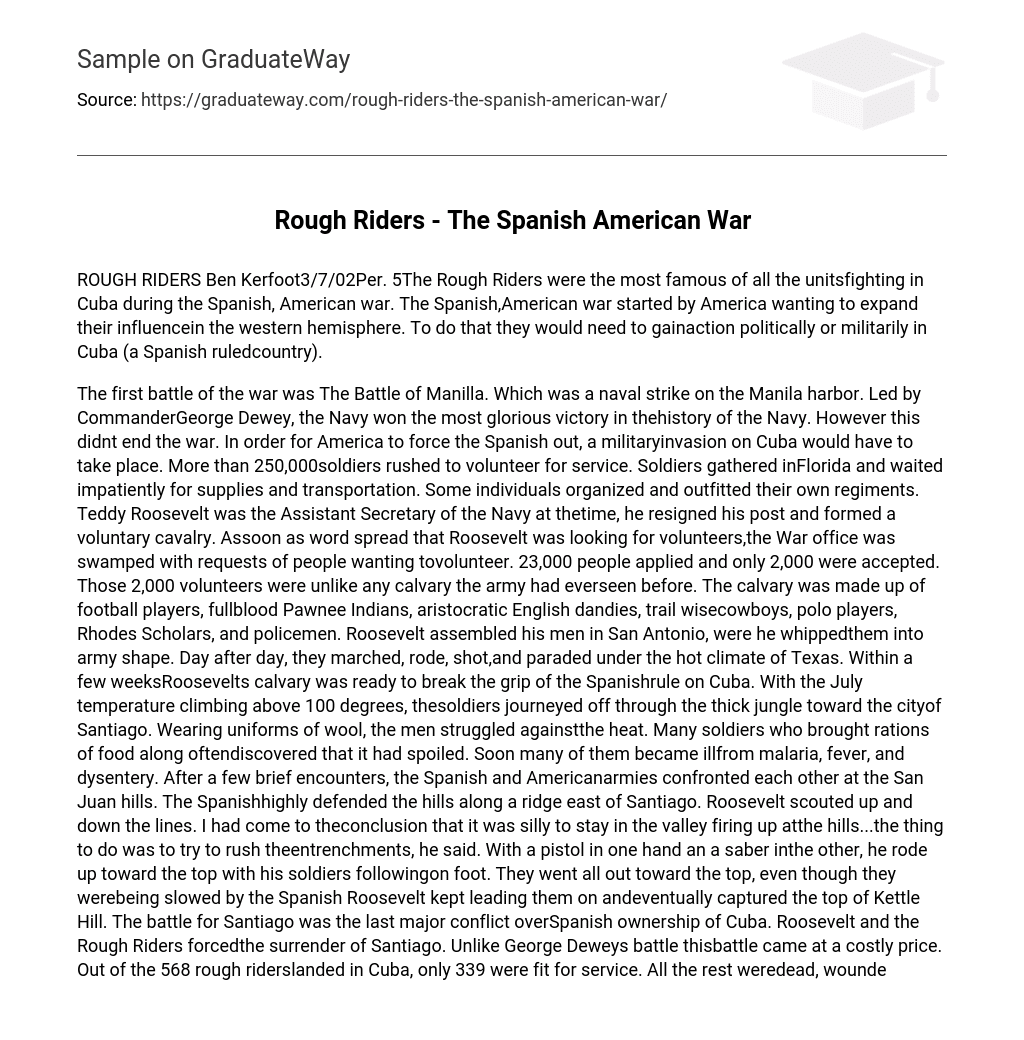The Rough Riders were the most famous of all the unitsfighting in Cuba during the Spanish, American war. The Spanish,American war started by America wanting to expand their influencein the western hemisphere. To do that they would need to gainaction politically or militarily in Cuba (a Spanish ruledcountry). The first battle of the war was The Battle of Manilla. Which was a naval strike on the Manila harbor. Led by CommanderGeorge Dewey, the Navy won the most glorious victory in thehistory of the Navy. However this didnt end the war.
In order for America to force the Spanish out, a militaryinvasion on Cuba would have to take place. More than 250,000soldiers rushed to volunteer for service. Soldiers gathered inFlorida and waited impatiently for supplies and transportation. Some individuals organized and outfitted their own regiments. Teddy Roosevelt was the Assistant Secretary of the Navy at thetime, he resigned his post and formed a voluntary cavalry.
Assoon as word spread that Roosevelt was looking for volunteers,the War office was swamped with requests of people wanting tovolunteer. 23,000 people applied and only 2,000 were accepted. Those 2,000 volunteers were unlike any calvary the army had everseen before. The calvary was made up of football players, fullblood Pawnee Indians, aristocratic English dandies, trail wisecowboys, polo players, Rhodes Scholars, and policemen.
Roosevelt assembled his men in San Antonio, were he whippedthem into army shape. Day after day, they marched, rode, shot,and paraded under the hot climate of Texas. Within a few weeksRoosevelts calvary was ready to break the grip of the Spanishrule on Cuba. With the July temperature climbing above 100 degrees, thesoldiers journeyed off through the thick jungle toward the cityof Santiago. Wearing uniforms of wool, the men struggled againstthe heat. Many soldiers who brought rations of food along oftendiscovered that it had spoiled.
Soon many of them became illfrom malaria, fever, and dysentery. After a few brief encounters, the Spanish and Americanarmies confronted each other at the San Juan hills. The Spanishhighly defended the hills along a ridge east of Santiago. Roosevelt scouted up and down the lines. I had come to theconclusion that it was silly to stay in the valley firing up atthe hills…the thing to do was to try to rush theentrenchments, he said. With a pistol in one hand an a saber inthe other, he rode up toward the top with his soldiers followingon foot.
They went all out toward the top, even though they werebeing slowed by the Spanish Roosevelt kept leading them on andeventually captured the top of Kettle Hill. The battle for Santiago was the last major conflict overSpanish ownership of Cuba. Roosevelt and the Rough Riders forcedthe surrender of Santiago. Unlike George Deweys battle thisbattle came at a costly price.
Out of the 568 rough riderslanded in Cuba, only 339 were fit for service. All the rest weredead, wounded or sick. That July 1st was by far the mostglorious day in Roosevelts storied life. Roosevelt became themost famous man in America that day. One problem with capturing Cuba was a disease called yellowfever, which was carried by mosquitoes. During the course ofaction, 29,000 Americans were exposed to it.
Back then there wasno known medicine that could fight the disease. So the bigquestion was, what to do with the troops? Their decision was tomove the soldiers to Montauk. Montauk was a completely isolatedcity. The medical wisdom back then was strange. They believedthat the disease was airborne, and since Montauk was on the coastthe shore winds would carry the disease out to sea.
The 29,000 Spanish American veterans set sail from Cuba forMontauk. They arrived at what they still call Rough RidersLanding, on Fort Pond Bay, on August 14,1898. A small yetenthusiastic crowd awaited them. The crowd roared as the hero ofSan Juan Hill, Theodore Roosevelt stepped off the ship. Areporter asked how he felt, Roosevelt replied Im in adisgracefully healthy condition! Ive had a bully time and abully fight! I feel as strong as a Bull Moose!Frightening headlines began to take place, It is MurderThat is Being Done at Montauk, was one of them, however theproblems were real.
Montauks barren landscape was problemenough, hundreds of tents had to be pitched, miles of telephonewire run, wells sunk, latrines dug, and field hospitals andkitchens erected. Thank God there was lots of unexpected help that began toarrive. The most important was the Womens National War ReliefAssociation. Thanks to them, the soldiers were so much improvedin health that by the beginning of September they were able to gohome.
BIBLIOGRAPHY
- Internet:www.montauklife.com/teddy98.html
- Internet:www.smplanet.com/imperialism/splendid.html
- Internet:www.lcweb.loc.gov/rr/hispanic/1898/roughriders.html





